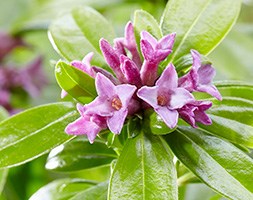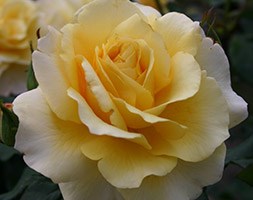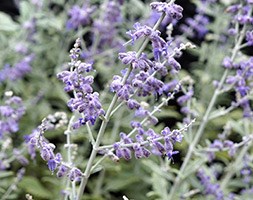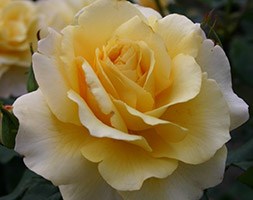New products at Crocus
by Sarah - May 29th, 2015.Filed under: Crocus, New Products.
New products at Crocus
Daphne ‘Sweet Amethyst’ (daphne) £29.99
Position: full sun or partial shade Soil: moderately fertile, well-drained, humus-rich soil Rate of growth: slow-growing Flowering period: March to April Hardiness: frost hardy (may need winter protection) Garden care: Keep pruning to a minimum since the plant is susceptible to die-back. Where necessary after flowering, lightly trim to remove misplaced branches and maintain a compact habit.
Rosa ‘Sunny Sky’ (Rose of the Year 2015 Rose Sunny Sky) £24.99
Position: full sun Soil: fertile, humus-rich, moist, well-drained soil Rate of growth: fast-growing Flowering period: June to September Hardiness: fully hardy Voted Rose of the year for 2016, this repeat flowering hybrid tea rose produces large flowers. It is quite a distinctive new rose, that is the result of selective breeding by W. Kordes. Its lightly fruity scented flowers, its honey-yellow buds lighten to soft yellow. The petals have a darker coloured base . It is said to have excellent disease resistance too. It is an easy care choice for novice or experienced gardeners. All our roses are grown in an open field and then dug up when the weather conditions are right in October or November. Some suppliers send out their roses as ‘bare root’ plants (ie without pots or compost), but we pot ours up as it helps to keep the roots hydrated and in good condition. As they are dormant throughout the winter, they will not produce any new roots until spring, so don’t be surprised if the compost falls away from the roots when you take them out of their pots. The roses can be kept in their pots throughout the winter provided they are kept well fed and watered, however ideally they should planted out as soon as possible. They will already have been cut back so no further pruning will be required, apart from snipping off any tips that have died back. Routine pruning can begin in late winter the year after planting. Garden care: If planting in winter, choose a frost-free spell when the soil is not frozen. Roses are quite deep-rooted plants so dig a deep hole roughly twice as wide as the plants roots and mix in a generous amount of composted organic matter. A top-dressing of a general purpose fertiliser can be worked into the surrounding soil and we also recommend using Rose Rootgrow at this stage to encourage better root development. This is particularly important when planting into a bed where roses have previously been grown as Rose Rootgrow is said to combat rose sickness (aka. replant disease). Gently spread out the roots before placing them in the centre of the hole. Try to ensure that the ‘bud union’ (the point where the cultivated rose has been grafted onto the rootstock, and from where the shoots emerge) is at soil level. You can judge this quite easily by laying something flat, like a spade handle or bamboo cane, across the top of the hole. When they are at the right he
Perovskia Silvery Blue (‘Lissvery’) (PBR) (Russian sage) £19.99
Position: full sun Soil: well-drained, poor to moderately fertile Rate of growth: average Flowering period: August and September Hardiness: fully hardy plants, or in swathes in a sunny border. It can also cope with dry, chalky soils and coastal conditions. Garden care: In March cut back to the permanent framework of the shrub. After pruning apply a generous 5-7cm (2-3in) mulch of well-rotted garden compost or manure around the base of the plant.
Rosa ‘Sunny Sky’ (Rose of the Year 2016 Rose Sunny Sky) £19.99
Position: full sun Soil: fertile, humus-rich, moist, well-drained soil Rate of growth: fast-growing Flowering period: June to September Hardiness: fully hardy Voted Rose of the year for 2016, this repeat flowering hybrid tea rose produces large flowers. It is quite a distinctive new rose, that is the result of selective breeding by W. Kordes. Its lightly fruity scented flowers, its honey-yellow buds lighten to soft yellow. The petals have a darker coloured base . It is said to have excellent disease resistance too. It is an easy care choice for novice or experienced gardeners. All our roses are grown in an open field and then dug up when the weather conditions are right in October or November. They will already have been cut back so no further pruning will be required, apart from snipping off any tips that have died back. Routine pruning can begin in late winter the year after planting. Garden care: If planting in winter, choose a frost-free spell when the soil is not frozen. Roses are quite deep-rooted plants so dig a deep hole roughly twice as wide as the plants roots and mix in a generous amount of composted organic matter. A top-dressing of a general purpose fertiliser can be worked into the surrounding soil and we also recommend using Rose Rootgrow at this stage to encourage better root development. This is particularly important when planting into a bed where roses have previously been grown as Rose Rootgrow is said to combat rose sickness (aka. replant disease). Gently spread out the roots before placing them in the centre of the hole. Try to ensure that the ‘bud union’ (the point where the cultivated rose has been grafted onto the rootstock, and from where the shoots emerge) is at soil level. You can judge this quite easily by laying something flat, like a spade handle or bamboo cane, across the top of the hole. When they are at the right height, back-fill the hole, firming the soil down gently before watering the plant well. Water generously until well established, and apply a specialist rose fertiliser (following the manufacturers instructions) each spring. They will also benefit from a generous mulch of composted farmyard manure in spring, but make sure this is kept away from the stems. While wearing tough gloves, prune in late winter or early spring, removing any dead, damaged or weak-looking stems completely. The younger stems tend to produce the best flowers, so










